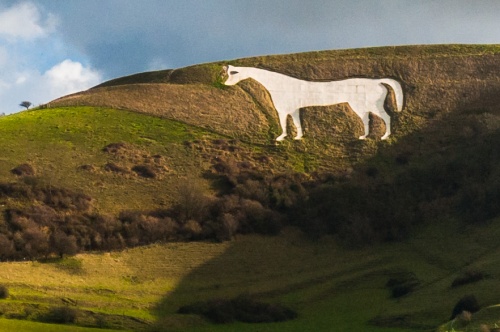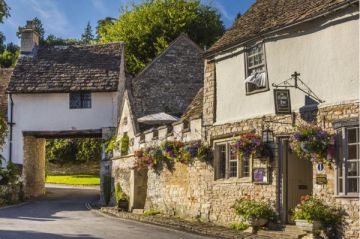
Wiltshire's best-known hill figure, cut into the slope of a hill beneath Bratton Camp Iron Age hillfort. Curiously, it is the only horse figure in the county to be shown standing still, rather than galloping. The horse measures 108 feet from nose to tail and stands 182 feet high.
How old is it?
The short answer is that we don't know, but it is most likely just over 300 years old. It is easy to assign a prehistoric - or at least a pre-Christian - date to hill figures, but most are of post-medieval origin. As for Westbury's horse, the first written records suggest that the horse was carved from the chalk slope of Bratton Hill in the late 17th century.
It is thought to commemorate King Alfred the Great's victory over the Danes at Ethandun (The Battle of Edington), which took place near Bratton Camp in 878AD. There are written records from 1742, but antiquarian John Aubrey, writing in the late 17th century, makes no mention of the horse, so it seems safe to assume that the horse was created after Aubrey and prior to 1742.
The Westbury White Horse is the oldest known hill figure in Wiltshire. It is such a well-known local landmark that the white chalk was covered by turf and brushwood during WWII to make it hard for German pilots to make it out from the air.

Why a 'White Horse'?
Popular mythology during the 17th-19th century associated the Saxons with bringing Christianity to Britain. We're not quite sure how such a story developed, but it probably goes back to the oldest white horse in Britain, at Uffington, in Oxfordshire.
Folk tales suggested that the Saxons had created the Uffington horse to celebrate a victory over the pagan Danes. So white horses became associated with every real or imagined Saxon victory over the pagan Danes. At Westbury, the horse was a mark of the Christian Alfred's triumph over the pagan Danes under Guthrun.
The horse was created by simply removing the turf to expose underlying chalk. The outline had to be regularly scoured to keep the white colour. Since the 1950s the white colour has been retained by using white-coloured concrete.
In 1778 the original horse was recut, perhaps under the direction of Mr Gee, who surveyed the parish for the Earl of Abingdon.
Visiting the White Horse
There are two ways to visit the white horse. One is via Newtown and Long River Road, signposted from the centre of Westbury. This leads up to Bratton Camp and a parking area inside the outer earthworks of the hillfort.
From the parking area, there is a level walk to an observation terrace with several benches and an information panel. You can walk right along the top of the horse and stand beside the horse's ear to look down the figure itself. However, to actually get the best view of the horse from straight on, your best bet is a layby and parking area on the north side of the B3098 at OS grid ST885516.



About Westbury White Horse
Address: Port Way, Bratton Road, Westbury,
Wiltshire,
England, BA13 3EP
Attraction Type: Prehistoric Site
Location: Park as for Bratton Camp, signposted from Bratton and Westbury, off the B3098, one mile south-west of Bratton. Free parking and an observation point with information panels.
Location
map
OS: ST898516
Photo Credit: David Ross and Britain Express
HERITAGE
 We've 'tagged' this attraction information to help you find related historic attractions and learn more about major time periods mentioned.
We've 'tagged' this attraction information to help you find related historic attractions and learn more about major time periods mentioned.
Find other attractions tagged with:
NEARBY HISTORIC ATTRACTIONS
Heritage Rated from 1- 5 (low to exceptional) on historic interest
Bratton Camp Hillfort - 0.1 miles (Prehistoric Site) ![]()
Bratton, St James Church - 1 miles (Historic Church) ![]()
Edington Priory Church - 2 miles (Historic Church) ![]()
Old Dilton, St Mary's Church - 3.1 miles (Historic Church) ![]()
Steeple Ashton Church - 3.4 miles (Historic Church) ![]()
Chapel of St Lawrence, Warminster - 4.3 miles (Historic Church) ![]()
Imber, St Giles Church - 4.6 miles (Historic Church) ![]()
Cley Hill Hillfort - 5.6 miles (Prehistoric Site) ![]()
Nearest Holiday Cottages to Westbury White Horse:
Bradford-on-Avon, Wiltshire
Sleeps: 4
Stay from: £408 - 1125
More self catering near Westbury White Horse



